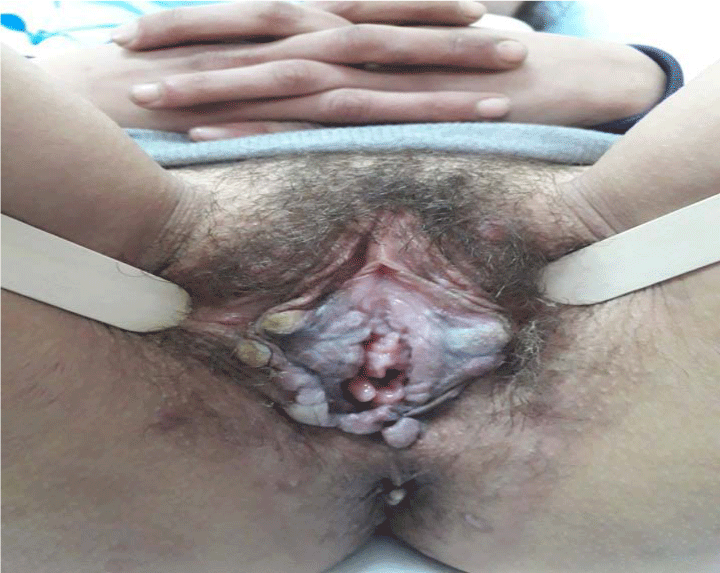Case Report
Condylomata Lata on the Vulva
Milan Bjekić1 and Hristina Vlajinac2*
1City Institute for Skin and Venereal Diseases, Serbia
2Institute of Epidemiology, University of Belgrade, Serbia
*Corresponding author: Hristina Vlajinac, Institute of Epidemiology,
University of Belgrade, Kursulina 6-8, 11000 Belgrade, Serbia, Tel: 381 11
2439-659; Fax: 381 11 3249-192; Email:
kristiv@eunet.rs
Submitted: 20 May 2019; Accepted: 06 June 2019; Published: 08 June 2019
Cite this article: Bjekic M, Vlajinac H (2019) Condylomata Lata on the Vulva. JSM
Obstet Gynecol 5: 2.
We report condylomata lata on the vulva in 25-year-old woman as an isolated manifestation of secondary syphilis who responded
favorably to treatment with penicillin. Gynecologists must stay alert and consider syphilis in the differential diagnosis of unusual papular
and warts-like lesions of the vulva.
Keywords: Condylomata lata; Secondary syphilis; Vulva
Syphilis is a venereal disease caused by Treponema pallidum.
In 2012, there were estimated 5.6 million new syphilis cases
in women and men aged 15-49 years globally [1]. Untreated,
syphilis passes through four stages: primary, secondary, latent
and tertiary. With the patient’s consent, we present a case of
condylomata lata, one of extremely broad spectrum of skin and
mucosal lesions seen in patients with secondary syphilis [2].
A 25-year-old woman is presented with a four-week history
of painless verrucous lesions in her genital area. She was referred
by a gynecologist to an outpatient clinic for skin and venereal
diseases. Physical examination revealed the warty, non-painful
numerous lesions on the vulva (Figure 1). Further examination
showed no other mucous membrane lesions or cutaneous
manifestations. She was HIV-negative and otherwise healthy.
Laboratory findings, including complete blood count and blood
chemistry were within normal limits.
Patient had unprotected vaginal sex with an unknown
partner 3 months before the onset of the lesion. Serological
results included positive nontreponemal reaction - Venereal
Disease Research Laboratory (VDRL) test titer was 1:64, with
specific Treponema Pallidum Haemagglutination Assay (TPHA)
test being positive as well. Clinical manifestations and positive
serologic tests for syphilis confirmed the diagnosis of secondary
syphilis, and condylomata lata were the only symptom of the disease.
The patient was treated with a single dose of 2.4 million
units of intramuscular benzathine penicillin G and the lesions
completely subsided three weeks after the treatment. Six months
later, the VDRL titer significantly declined (1:4).
Condylomata lata are characterized by the flat moist papules
or elevated verrucous or cauliflower-like papules or plaque
usually located at sites where two body surfaces are in apposition
such as anogenital areas. Characteristics of this site are constant
moisture, friction and maceration facilitating coalescence and
growth of these highly contagious lesions.
Condylomata acuminata or bowenoid papulosis which are
associated with human papillomavirus infection are common
mimickers of condylomata lata. The diagnosis of condylomata
lata is based on typical skin lesions and positive serologic tests for syphilis.
Gynecologists must stay alert and consider syphilis in the
differential diagnosis of unusual papular and warts-like lesions
of the vulva.
 Figure 1: Multiple flesh-colored and whitish verrucose nodules and
plaques on the vulva. View Figure
Figure 1: Multiple flesh-colored and whitish verrucose nodules and
plaques on the vulva. View Figure






























